Source: In Communion
Jim Forest | 31 March 2015
Mother Maria Skobtsova — now recognized as Saint Maria of Paris — died in a German concentration camp on the 30th of March 1945.
The Challenge of a 20th Century Saint, Maria Skobtsova
Although perishing in a gas chamber, Mother Maria did not perish in the Church’s memory. Those who had known her would again and again draw attention to the ideas, insights and activities of the heroic nun who had spent so many years of her life assisting people in desperate need. Soon after the war ended, essays and books about her began appearing in French, Russian and English. A Russian film, “Mother Maria,” was made in 1982. Her canonization was celebrated in May 2004 at the Cathedral of St. Alexander Nevsky in Paris. Among those present at the event was Cardinal Jean-Marie Lustiger, archbishop of Paris and Jewish by birth, who subsequently placed St. Maria on the calendar of the Catholic Church in France. One wonders if there are any other saints of post-Schism Christianity who are on both the Catholic and Orthodox calendars?
We have no time today for a detailed account of her life. I will only point out that she was born in Riga in 1891 and grew up on a family estate along the Black Sea. Her father’s death when she was fourteen was a devastating event that for a time led her to atheism, but gradually she found her way back to the Orthodox faith. As a young woman, she was the first female student at the St. Petersburg Theological Academy. In the same period she witnessed the Bolshevik coup and the civil war that followed. Like so many Russians, she fled for her life, finally reaching Paris, where she was among those who devoted themselves to serving fellow refugees, many of whom were now living in a state of destitution even worse than her own. At that time, she worked with the Student Christian Movement.
Elizaveta Skobtsova with the children. Anastasia is on the left.
The tragic death in 1926 of one her daughters, Anastasia, precipitated a decision that brought her to a still deeper level of self-giving love. In 1932, following the collapse of her marriage, her bishop, Metropolitan Evlogy, encouraged her to become a nun, but a nun with an exceptional vocation. Metropolitan Evlogy blessed her to develop a new type of monasticism — a “monasticism in the world” — that centered on diaconal service within the city rather than on quiet withdrawal in a rural context.
In a time of massive social disruption, Mother Maria declared, it was better to offer a monastic witness which opens its gates to desperate people and in so doing to participate in Christ’s self-abasement. “Everyone is always faced … with the necessity of choosing between the comfort and warmth of an earthly home, well protected from winds and storms, and the limitless expanse of eternity, which contains only one sure and certain item … the Cross.”
It was clear to her that it was not only Russia which was being torn to shreds. “There are times,” she wrote, “when all that has been said cannot be made obvious and clear since the atmosphere around us is a pagan one and we are tempted by its idolatrous charms. But our times are firmly in tune with Christianity in that suffering is part of their nature. They demolish and destroy in our hearts all that is stable, mature, hallowed by the ages and treasured by us. They help us genuinely and utterly to accept the vows of poverty, to seek no rule, but rather anarchy, the anarchic life of Fools for Christ’s sake, seeking no monastic enclosure, but the complete absence of even the subtlest barrier which might separate the heart from the world and its wounds.”
She saw that there were two ways to live. The first was on dry land, a legitimate and respectable place to be, where one could measure, weigh and plan ahead. The second was to walk on the waters where “it becomes impossible to measure or plan ahead. The one thing necessary is to believe all the time. If you doubt for an instant, you begin to sink.”
The water she decided to walk upon was a vocation of hospitality. With financial support from Metropolitan Evlogy, in December 1932 she signed a lease for her first house of hospitality, a place of welcome and assistance to people in desperate need, mainly young Russian women. The first night she slept on the floor beneath the icon of the Protection of the Mother of God. A small community of co-workers began to form. To make room for others, Mother Maria gave up her own room and instead slept on an iron bedstead in the basement by the boiler. A room upstairs became a chapel.
The first house having become too small, in 1934 the community relocated to a three-storey house at 77 rue de Lourmel in an area of Paris where many impoverished Russian refugees had settled. Now, instead of 25 people, the community could feed a hundred. Stables in back became a small church.
The vocation of hospitality is much more than the provision of food, clothing and a place to sleep. In its depths, it is a contemplative vocation. It is the constant search for the face of Christ in the stranger. “If someone turns with his spiritual world toward the spiritual world of another person,” she reflected, “he encounters an awesome and inspiring mystery …. He comes into contact with the true image of God in man, with the very icon of God incarnate in the world, with a reflection of the mystery of God’s incarnation and divine manhood. And he needs to accept this awesome revelation of God unconditionally, to venerate the image of God in his brother. Only when he senses, perceives and understands it will yet another mystery be revealed to him — one that will demand his most dedicated efforts…. He will perceive that the divine image is veiled, distorted and disfigured by the power of evil…. And he will want to engage in battle with the devil for the sake of the divine image.”
By 1937, there were several dozen women guests at 77 rue de Lourmel. Up to 120 dinners were served each day. Other buildings were rented, one for families in need, another for single men. A rural property became a sanatorium.
From a financial point of view, it was a very insecure life, but somehow the work survived and grew. Mother Maria would sometimes recall the Russian story of the ruble that could never be spent. Each time it was used, the change given back proved to equal a ruble. It was exactly this way with love, she said: No matter how much love you give, you never have less. In fact you discover you have more — one ruble becomes two, two becomes ten.
The house at rue de Lourmel
Mother Maria’s day typically began with a journey to Les Halles to beg food or buy cheaply whatever was not donated. The cigarette-smoking beggar nun became well known among the stalls. She would later return with a sack of bones, fish and overripe fruit and vegetables.
Metropolitan Anthony of Sourozh provides an impression of what Mother Maria was like in those days: “She was a very unusual nun in her behavior and her manners. I was simply staggered when I saw her for the first time. I was walking along the Boulevard Montparnasse. In front of a café, there was a table, on the table was a glass of beer, and behind the glass was sitting a Russian nun in full monastic robes. I looked at her and decided that I would never go near that woman. I was young then and held extreme views.”
Mother Maria felt sustained by the opening verses of the Sermon on the Mount: “Not only do we know the Beatitudes, but at this hour, this very minute, surrounded though we are by a dismal and despairing world, we already savor the blessedness they promise.”
Life in community was not easy. Conflicting views about the relative importance of liturgical life were at times a source of tension. Mother Maria was the one most often absent from services or the one who would withdraw early, or arrive late, because of the pressing needs of hospitality. “Piety, piety,” she wrote in her journal, “but where is the love that moves mountains?”
Mother Maria saw blessings where others only saw disaster. “In the past religious freedom was trampled down by forces external to Christianity,” she wrote. “In Russia we can say that any regime whatsoever will build concentration camps as its response to religious freedom.” She considered exile in the west a heaven-sent opportunity to renew the Church in ways that would have met repression within her mother country.
For her, exile was an opportunity “to liberate the real and authentic” from layers of decoration and dust in which Christ had become hidden. It was similar to the opportunity given to the first Christians. “We must not allow Christ,” she said, “to be overshadowed by any regulations, any customs, any traditions, any aesthetic considerations, or even any piety.”
Russians have not been last among those enamored with theories, but for Mother Maria, all theories had to take second place. “We have not gathered together for the theoretical study of social problems in the spirit of Orthodoxy,” she wrote, “[but] to link our social thought as closely as possible with life and work. More precisely, we proceed from our work and seek the fullest possible theological interpretation of it.”
While many valued what she and her co-workers were doing, there were others who were scandalized with the shabby nun who was so uncompromising in her hospitality that she might leave a church service to answer the door bell. “For many in church circles we are too far to the left,” she noted, “while for the left we are too church-minded.”
In October 1939, Metropolitan Evlogy send a priest to rue de Lourmel: Father Dimitri Klépinin, then 35 years old. A man of few words and great modesty, Fr. Dimitri proved to be a real partner for Mother Maria.
The last phase of Mother Maria’s life was a series of responses to World War II and Germany’s occupation of France.
Her basic choice was the decision to stay. It would have been possible for her to leave Paris when the Germans were advancing, or even to leave the country to go to America, but she would not budge. “If the Germans take Paris, I shall stay here with my old women. Where else could I send them?”
She had no illusions about Nazism. It represented a “new paganism” bringing in its wake disasters, upheavals, persecutions and wars. It was evil unveiled, the “contaminator of all springs and wells.” The so-called “master race” was “led by a madman who needs a straightjacket and should be placed in a cork-lined room so that his bestial wailing will not disturb the world at large.”
Paris fell on the 14th of June. With defeat came greater poverty and hunger for many people. Local authorities in Paris declared the house at rue de Lourmel an official food distribution point.
Paris was now a prison. “There is the dry clatter of iron, steel and brass,” wrote Mother Maria. “Order is all.” Russian refugees were among the high-priority targets of the occupiers. In June 1941, a thousand were arrested, including several close friends of Mother Maria and Fr. Dimitri. An aid project for prisoners and their dependents was soon launched by Mother Maria.
Early in 1942, with Jewish registration underway, Jews began to knock on the door at rue de Lourmel asking Fr. Dimitri if he would issue baptismal certificates to them. The answer was always yes. The names of those “baptized” were also duly recorded in his parish register in case there was any cross-checking by the police or Gestapo, as indeed did happen. Fr. Dimitri was convinced that in such a situation Christ would do the same.
In March 1942, the order came from Berlin that a yellow star must be worn by Jews in all the occupied countries. The order came into force in France in June. There were, of course, Christians who said that the law being imposed had nothing to do with Christians and that therefore this was not a Christian problem. “There is not only a Jewish question, but a Christian question,” Mother Maria replied. “Don’t you realize that the battle is being waged against Christianity? If we were true Christians we would all wear the star. The age of confessors has arrived.”
In July, Jews were forbidden access to nearly all public places. Shopping by Jews was restricted to an hour per day. A week later, there was a mass arrest of Jews — 12,884, of whom 6,900 (two-thirds of them children) were brought to a sports stadium just a kilometer from rue de Lourmel. Held there for five days, the captives in the stadium received water only from a single hydrant. From there the captives were to be sent to Auschwitz.
Mother Maria had often thought her monastic robe a God-send in aiding her work. Now it opened the way for her to enter the stadium. Here she worked for three days trying to comfort the children and their parents, distributing what food she could bring in, even managing to rescue a number of children by enlisting the aid of garbage collectors and smuggling them out in trash bins.
The house at rue de Lourmel was bursting with people, many of them Jews. “It is amazing,” Mother Maria remarked, “that the Germans haven’t pounced on us yet.” In the same period, she said if anyone came looking for Jews, she would show them an icon of the Mother of God.
Fr. Dimitri, Mother Maria and their co-workers set up routes of escape to the unoccupied south. It was complex and dangerous work. Forged documents had to be obtained. An escaped Russian prisoner of war was also among those assisted, working for a time in the Lourmel kitchen. In turn, a local resistance group helped secure provisions for those Mother Maria’s community was struggling to feed.
In February 1943 Mother Maria, her son Yuri, Fr. Dimitri and their collaborator Ilya Fondaminsky were arrested by the Gestapo and sent to the camp at Compiegne.
In December, Yuri and Fr. Dimitri were deported to Buchenwald concentration camp in Germany and from there to Dora, 40 kilometers away. On the 6th of February, Yuri was “dispatched for treatment” — a euphemism for being sentenced to death. Four days later Fr. Dimitri, lying on a dirt floor, died of pneumonia. His final action was to make the sign of the Cross. His body was disposed of in the Buchenwald crematorium.
Mother Maria was sent to Ravensbrück in Germany, where she endured for two years, an achievement in part explained by her long experience of ascetic life. “She was never downcast, never,” a fellow prisoner recalled. “She never complained…. She was on good terms with everyone. Anyone in the block, no matter who it was, knew her on equal terms. She was the kind of person who made no distinction between people [whether they] held extremely progressive political views [or had] religious beliefs radically different than her own. She allowed nothing of secondary importance to impede her contact with people.”
By March 1945, Mother Maria’s condition was critical. She had to lie down between roll calls and hardly spoke. Her face, a fellow prisoner Jacqueline Pery recalled, “revealed intense inner suffering. Already it bore the marks of death. Nevertheless Mother Maria made no complaint. She kept her eyes closed and seemed to be in a state of continual prayer. This was, I think, her Garden of Gethsemani.”
She died on Holy Saturday. The shellfire of the approaching Red Army could be heard in the distance. We are not certain of the details of her last day. According to one account, she was simply among the many selected for death that day. According to another, she took the place of another prisoner, a Jew. Jacqueline Pery wrote afterward: “It is very possible that [Mother Maria] took the place of a frantic companion. It would have been entirely in keeping with her generous life. In any case she offered herself consciously to the holocaust … thus assisting each one of us to accept the Cross…. She radiated the peace of God and communicated it to us.”
We now know Mother Maria as St. Maria of Paris. Her commemoration occurs on July 20.
Every saint poses a challenge, but Mother Maria is perhaps among the most challenging saints. Her life is a passionate objection to any form of Christianity that seeks Christ chiefly inside church buildings. Still more profoundly, she challenges each of us to a life of a deeper, more radical hospitality, a hospitality that includes not only those who share our faith and language but those whom we regard as “the other,” people in whom we resist recognizing the face of Christ.
Mother-Maria-Fostoropoulis
Mother Maria was certain that there was no other path to heaven than participating in God’s mercy. “The way to God lies through love of people. At the Last Judgment I shall not be asked whether I was successful in my ascetic exercises, nor how many bows and prostrations I made. Instead I shall be asked, Did I feed the hungry, clothe the naked, visit the sick and the prisoners. That is all I shall be asked. About every poor, hungry and imprisoned person the Savior says ‘I’: ‘I was hungry and thirsty, I was sick and in prison.’ To think that he puts an equal sign between himself and anyone in need…. I always knew it, but now it has somehow penetrated to my sinews. It fills me with awe.”
We can sum up Mother Maria’s credo in just a few words: “Each person is the very icon of God incarnate in the world.”
Source: http://www.pravmir.com/the-challenge-of-a-20th-century-saint-maria-skobtsova/#ixzz3gjfXOKrF
A Canonization in Munich: Saint Alexander Schmorell
by Jim Forest
my source: Jim Forest
Saints come in many sizes and varieties, ranging from kings to beggars, surgeons to street sweepers, scholars to the illiterate, the extraordinary to the unnoticed. Some never marry, some are the parents of large families. Some die in bed in their old age, others die early in life at the hands of executioners. There are millions of saints — heaven is crowded — but relatively few of heaven’s population have been formally canonized. The vast majority are rank-and-file saints, an inspiration to those who knew them, but never placed by name on the church calendar.
Reporting on canonizations, journalists often say that so-and-so was “made a saint” today at such-and-such location, but in fact the Church does not make saints. Canonization is merely an act of carefully considered recognition that a particular person became a saint in his lifetime and is unquestionably among the blessed and thus in no need of our prayers for his forgiveness and salvation. The saints who are singled out for special recognition are mentioned at the Liturgy on a particular day every year, some locally or nationally, others in churches around the world. They are also depicted in icons in both churches and homes.
What is it that makes the Church occasionally canonize a particular saint? In many cases it has to do with some remarkable quality or achievement — their exceptional impact on other lives. The memory of their works and lives needs to be passed on from generation to generation in order to encourage others to follow in their footsteps. It is one of the ways the Church declares, “This is sanctity. This is the path to eternal life.”
The majority of those canonized are martyrs. One of these — Alexander Schmorell — was added to the church calendar this past weekend. His canonization took place at the Cathedral of the New Martyrs and Confessors of Russia, a church in Munich not far from Schmorell’s grave. On the far side of the cemetery, at Stadelheim Prison, Schmorell was beheaded on 13 July 1943. He was only 25 at the time. He was an Orthodox Christian who had put his life at risk by being part of a anti-Nazi resistance group.
The canonization got underway on Saturday afternoon, February 3, as people began to gather in the church. Aware that the reporters and cameramen present would need certain photos before the ceremonies started, Fr. Nikolai Artemoff, dean of the cathedral, brought out the icon of Alexander Schmorell in anticipation of its formal presentation later in the day. Many photos were taken, a pre-canonization ceremony that would not have been imagined in earlier centuries. The icon showed Alexander Schmorell as the tall, brown-haired young man he was, wearing the white robe of a physician with a Red Cross arm band (he had been a medical student at Munich’s Maximilian University), his left hand raised in a gesture of greeting, the other holding a blood-red cross plus a white rose. He is standing against a pure gold background representing eternity and the kingdom of God.
As Father Nikolai explained to the journalists, the white rose in his hand symbolizes the White Rose group Schmorell co-founded with Hans Scholl in the spring of 1942. Before the arrests began the following February, the group succeeded — assisted by friends in many German and Austrian cities and towns — in widely distributing a series of six anti-Nazi leaflets. All six members of the core group were guillotined. (The story is powerfully told in an the Oscar-nominated film, “Sophie Scholl – The Final Days,” much of which was photographed in Munich.)
Press photos taken and interviews completed, at about 4 PM a procession of about two hundred people set out led by a cross bearer. Behind the cross were six bishops: Archbishop Mark (who leads the Russian Orthodox Church Outside Russia in Germany), Metropolitan Valentin of Orenburg (the Russian city where Schmorell was born), Metropolitan Onufriy of Czernowitz in Ukraine, Archbishop Feofan of Berlin, Bishop Michael of Geneva, and Bishop Agapit of Stuttgart. How many priests? I lost count.
The frigid air was challenging — it was about 15 degrees below zero Centigrade (5 degrees Fahrenheit), with snow and ice on the ground. Though the cemetery, Perlacher Forst, was just across the street, its entrance was several hundred meters away. Once inside the gate, we wound our way through tombstone-lined paths, first stopping to pray at the graves of Hans and Sophie School, the brother and sister who were the first to be executed from the White Rose group, and Christoph Probst, beheaded the same day — 22 February 1943. Here three tall black crosses stand side by side, a single cross piece linking the crosses over the Scholl graves. Sophie, the one woman in the White Rose inner circle, and the youngest, was 21 when she was killed. Today many German streets and squares are named in honor of Sophie and Hans Scholl, Alexander Schmorell, Christoph Probst and others executed for their part in the White Rose. Hans and Sophie came from a closely-knit Lutheran family. Christoph Probst was baptized in the Catholic Church a day before his execution.
Archpriest Nikolai Artemoff placing a candle of the grave of St Alexander Schmorell
The high point of the day came during the Saturday evening Vigil, which began at 5 PM and lasted three-and-a-half hours, by which time an almost full moon was shining through the windows. In the middle of the service, several icon stands were placed in the center of the church with candle stands behind. At least a hundred candles were lit, forming a curtain of light. Finally a procession of bishops, clergy and altar servers poured out of the sanctuary carrying an icon of Saint Alexander Schmorell followed by another icon crowded with images of New Martyrs of the twentieth century. Next came a huge silver-bound Gospel book, a copy that had been a gift from Russia’s last czar, Nicholas II, to Russian Orthodox Christians in Germany. The two icons and the Gospel book were solemnly placed side by side on the stands, then incensed. Finally everyone in the church, beginning with the six bishops, venerated the icon of the newly recognized saint.
“When they brought out the icon,” Nancy told me later that night, “it was such a climax, with the servers holding all those fans over the icons and the choir singing with such exaltation. It was as it there were neon arrows pointing at the icon of Alexander Schmorell and saying, ‘This is what really matters.’ It’s the Church pulling out all the stops. They couldn’t do more to make you look in that direction and feel the importance, the challenge, of this brave life. You couldn’t not get it. This is what the Church does in interpreting human events and letting us know what’s truly valuable. This is something that requires all the ceremony the Church is capable of. But it’s not ceremony for its own sake. It’s all meant to confront us with the inner meaning of a young man putting his head on the chopping block. The canonization ceremony pulls you out of ordinary time and confronts you with the message: consider this life and let it influence your own.”
At the Liturgy the following morning, the church was even more crowded than it had been for the Vigil. We were jammed together like cigarettes in a carton — it was challenging to make the sign of the cross without grazing your neighbors with your elbows. Perhaps as many people were present as would fill the church for the All-Night Easter service. (Also present on Sunday– given a special chair placed at the right end of the iconostasis — was Bishop Engelbert Siebler, representing the Catholic Archdiocese of Munich.)
In the Orthodox Church every Sunday is regarded as a little Easter, but rarely have I experienced so intense a paschal radiance. Resurrection was at the heart of Father Nikolai’s sermon, delivered just before communion. He reminded us that the name the White Rose group adopted for itself had been proposed by Alexander Schmorell. His suggestion came from a story in the novel The Brothers Karamazov, written by Schmorell’s most beloved author, Dostoevsky. In one chapter Christ comes back to earth, “softly, unobserved, and yet, strange to say, every one recognized Him.” He is suddenly present among the many people in Seville’s cathedral square, a place were the pavement is still warm from the burning of a hundred heretics. Responding to a mother’s desperate appeal, Christ raises from the dead a young girl whose open coffin was being carried across the square on its way to the cemetery. Flowers have been laid on her body. “The procession halts, the coffin is laid on the steps at [Christ’s] feet. He looks with compassion, and His lips softly pronounce the words, ‘Maiden, arise!’ and she arises. The little girl sits up in the coffin and looks round, smiling with wide-open wondering eyes, holding a bunch of white roses they had put in her hand.” This merciful action completed, he is recognized by the Grand Inquisitor, who orders Christ’s arrest.
The white rose is a paschal symbol, a sign of the victory of life over death.
That Alexander Schmorell would one day be canonized at this cathedral had been evident for years. He is shown among of a row of twenty-two martyrs of the twentieth-century included in an icon that has long been part of the cathedral’s iconostasis. After the Liturgy and the emptying out of the church, I went to look more carefully at that older icon. Schmorell is easily picked out — there he is, in the first row, third from the right, wearing a white robe. What is remarkable is that, within the group, he alone group has no halo, for at the time the icon was painted canonization was only anticipated. In one hand he holds a thin cross, in the other a scroll with these words taken from his last letter to his parents:
“This difficult ‘misfortune’ was necessary to put me on the right road, and therefore was no misfortune at all…. What did I know until now about belief, about a true and deep belief, about the truth, the last and only truth, about God? Never forget God!!”
One can imagine future icons of Saint Alexander of Munich will often use the same text while other iconographers may decide to use his last words, spoken to his lawyer as he was being taken to the guillotine: “I’m convinced that my life has to end now, early as it seems, because I have fulfilled my life’s mission. I wouldn’t know what else I have to do on this earth.”
In a time when fear is being sold every minute of the day, every day of the year — where would the “war on terror” be were we not prisoners of fear? — the pilgrimage to Munich to honor a saint who had freed himself from the tyranny of fear gave me an injection of pure courage.
(report written 9 February 2012)
* * * * *
Extracts from Fr Nikolai Artemoff’s sermon:
Holy New Martyrs are glorified by the Church because, in the particular circumstances of their own times, they bore a clear witness to Christ and in so doing sacrificed their own lives. On July 13, 1943 Alexander Schmorell was executed by means of the guillotine in Munich’s Stadelheim Prison. On Sunday (in Russian, the “day of resurrection”) the 5th of February 2012, he shall take his place among the band of New Martyrs of Russia, to whom this cathedral church is dedicated.
The death of a martyr is always comprised of both the love for Christ as well as, through this love, the exposure of wickedness of evildoers in this world, and therefore also those who pave the way for Satan and his complict servant, the antichrist.
Alexander Schmorell’s favorite book was The Brothers Karamazov, from which the name “White Rose” hails, as a symbol of purity and resurrection (as evidenced in the resurrection of the girl at the appearance of Christ in Seville at the beginning of the “Legend of the Grand Inquisitor”). The path of Alexander Schmorell led from religious instruction which he received from priests in Munich, to the contribution of an Orthodox worldview via F.M. Dostoevsky in the catagorical repudiation of both regimes, enemies of man and idols that they have become of the “Fueher”, Hitler, as well as of Stalin, both nationalist and socialist. The “White Rose” considered Nazi rule as anti-Christian, but for Alexander Schmorell, no less anti-Christian was the regime in which his beloved was enslaved — Bolshevism. “I admit to my love of Russia without reservation. Therefore I also stand in opposition to Bolshevism.”
The last flyer of the White Rose primarily authored by Alexander Schmorell (Nr. IV) witnesses to his concept of the spiritual dimensions of this struggle in the name of God and his Son, Christ. He wrote:
(with thanks to Katja Yurschak for the translation of Fr. Nikolai’s words)
* * *
Hymns sung at the glorification of Saint Alexander of Munich (annual commemoration day July 13):
Troparion, tone 4:
Kontakion, tone 4:
* * *
A section of the web site of the Cathedral of the New Martyrs and Confessors of Russia is devoted to St Alexander Schmorell, with texts both in Russian and German:
http://www.sobor.de/index.php?option=com_content&view=category&layout=blog&id=79&Itemid=109&lang=de
A biographical essay (“Alexander Schmorell: a Witness in Dark Times”) is here: www.jimandnancyforest.com/2011/02/02/alexander-schmorell-a-witness-in-dark-times/
Russian translation of “Alexander Schmorell: a Witness in Dark Times”: http://www.sobor.de/index.php?option=com_content&view=article&id=272:alexander-schmorell-a-witness-in-dark-times&catid=79:alexander-schmorell-verherrlichung&Itemid=109&lang=ru
An English translation of Schmorell’s letters from prison:
www.katjasdacha.com/whiterose/alexbriefe_e.html
A set of photos of the canonization:
www.flickr.com/photos/jimforest/sets/72157629206699911/with/6832060277/
A set of photos having to do of the White Rose:
www.flickr.com/photos/jimforest/sets/72157625346459536/with/5161067764/
Wikipedia entry about the White Rose:
http://en.wikipedia.org/wiki/White_rose
* * *
Jim Forest is international secretary of the Orthodox Peace Fellowship — www.incommunion.org — and is the author of many books — see: http://www.jimandnancyforest.com/books/ . He belongs to St. Nicholas of Myra Russian Orthodox Church in Amsterdam and lives in Alkmaar, the Netherlands.
MOTHER MARIA SKOBTSOVA AND OTHERS, CATHOLIC, ORTHODOX AND LUTHERAN, WHOSE LIVES AND DEATHS REFLECTED GOD'S HOLINESS IN WWII:
A Canonization in Munich: Saint Alexander Schmorell
by Jim Forest
my source: Jim Forest
Saints come in many sizes and varieties, ranging from kings to beggars, surgeons to street sweepers, scholars to the illiterate, the extraordinary to the unnoticed. Some never marry, some are the parents of large families. Some die in bed in their old age, others die early in life at the hands of executioners. There are millions of saints — heaven is crowded — but relatively few of heaven’s population have been formally canonized. The vast majority are rank-and-file saints, an inspiration to those who knew them, but never placed by name on the church calendar.
Reporting on canonizations, journalists often say that so-and-so was “made a saint” today at such-and-such location, but in fact the Church does not make saints. Canonization is merely an act of carefully considered recognition that a particular person became a saint in his lifetime and is unquestionably among the blessed and thus in no need of our prayers for his forgiveness and salvation. The saints who are singled out for special recognition are mentioned at the Liturgy on a particular day every year, some locally or nationally, others in churches around the world. They are also depicted in icons in both churches and homes.
What is it that makes the Church occasionally canonize a particular saint? In many cases it has to do with some remarkable quality or achievement — their exceptional impact on other lives. The memory of their works and lives needs to be passed on from generation to generation in order to encourage others to follow in their footsteps. It is one of the ways the Church declares, “This is sanctity. This is the path to eternal life.”
Cathedral of the New Martyrs and Confessors of Russia
The majority of those canonized are martyrs. One of these — Alexander Schmorell — was added to the church calendar this past weekend. His canonization took place at the Cathedral of the New Martyrs and Confessors of Russia, a church in Munich not far from Schmorell’s grave. On the far side of the cemetery, at Stadelheim Prison, Schmorell was beheaded on 13 July 1943. He was only 25 at the time. He was an Orthodox Christian who had put his life at risk by being part of a anti-Nazi resistance group.
The canonization got underway on Saturday afternoon, February 3, as people began to gather in the church. Aware that the reporters and cameramen present would need certain photos before the ceremonies started, Fr. Nikolai Artemoff, dean of the cathedral, brought out the icon of Alexander Schmorell in anticipation of its formal presentation later in the day. Many photos were taken, a pre-canonization ceremony that would not have been imagined in earlier centuries. The icon showed Alexander Schmorell as the tall, brown-haired young man he was, wearing the white robe of a physician with a Red Cross arm band (he had been a medical student at Munich’s Maximilian University), his left hand raised in a gesture of greeting, the other holding a blood-red cross plus a white rose. He is standing against a pure gold background representing eternity and the kingdom of God.
As Father Nikolai explained to the journalists, the white rose in his hand symbolizes the White Rose group Schmorell co-founded with Hans Scholl in the spring of 1942. Before the arrests began the following February, the group succeeded — assisted by friends in many German and Austrian cities and towns — in widely distributing a series of six anti-Nazi leaflets. All six members of the core group were guillotined. (The story is powerfully told in an the Oscar-nominated film, “Sophie Scholl – The Final Days,” much of which was photographed in Munich.)
The frigid air was challenging — it was about 15 degrees below zero Centigrade (5 degrees Fahrenheit), with snow and ice on the ground. Though the cemetery, Perlacher Forst, was just across the street, its entrance was several hundred meters away. Once inside the gate, we wound our way through tombstone-lined paths, first stopping to pray at the graves of Hans and Sophie School, the brother and sister who were the first to be executed from the White Rose group, and Christoph Probst, beheaded the same day — 22 February 1943. Here three tall black crosses stand side by side, a single cross piece linking the crosses over the Scholl graves. Sophie, the one woman in the White Rose inner circle, and the youngest, was 21 when she was killed. Today many German streets and squares are named in honor of Sophie and Hans Scholl, Alexander Schmorell, Christoph Probst and others executed for their part in the White Rose. Hans and Sophie came from a closely-knit Lutheran family. Christoph Probst was baptized in the Catholic Church a day before his execution.
Archpriest Nikolai Artemoff placing a candle of the grave of St Alexander Schmorell
The procession than continued to Alexander Schmorell’s resting place, not far away. A bouquet of white roses was resting against the rough surface of the tombstone and more flowers heaped over the grave. Embedded in the stone was a bronze Russian Orthodox crucifix. Memorial prayers — a panikhida — was sung, concluding with the melodic two-word chant, Vyechnaya Pamyat (eternal memory), sung repeatedly by all present. Every year there has been a panikhida sung at this grave on the 13th of July, the anniversary of Schmorell’s death, but this was the final panikhida. Now that he has been officially glorified, future services at his grave no longer have a penitential character.
The high point of the day came during the Saturday evening Vigil, which began at 5 PM and lasted three-and-a-half hours, by which time an almost full moon was shining through the windows. In the middle of the service, several icon stands were placed in the center of the church with candle stands behind. At least a hundred candles were lit, forming a curtain of light. Finally a procession of bishops, clergy and altar servers poured out of the sanctuary carrying an icon of Saint Alexander Schmorell followed by another icon crowded with images of New Martyrs of the twentieth century. Next came a huge silver-bound Gospel book, a copy that had been a gift from Russia’s last czar, Nicholas II, to Russian Orthodox Christians in Germany. The two icons and the Gospel book were solemnly placed side by side on the stands, then incensed. Finally everyone in the church, beginning with the six bishops, venerated the icon of the newly recognized saint.
At the Liturgy the following morning, the church was even more crowded than it had been for the Vigil. We were jammed together like cigarettes in a carton — it was challenging to make the sign of the cross without grazing your neighbors with your elbows. Perhaps as many people were present as would fill the church for the All-Night Easter service. (Also present on Sunday– given a special chair placed at the right end of the iconostasis — was Bishop Engelbert Siebler, representing the Catholic Archdiocese of Munich.)
The white rose is a paschal symbol, a sign of the victory of life over death.
“This difficult ‘misfortune’ was necessary to put me on the right road, and therefore was no misfortune at all…. What did I know until now about belief, about a true and deep belief, about the truth, the last and only truth, about God? Never forget God!!”
One can imagine future icons of Saint Alexander of Munich will often use the same text while other iconographers may decide to use his last words, spoken to his lawyer as he was being taken to the guillotine: “I’m convinced that my life has to end now, early as it seems, because I have fulfilled my life’s mission. I wouldn’t know what else I have to do on this earth.”
In a time when fear is being sold every minute of the day, every day of the year — where would the “war on terror” be were we not prisoners of fear? — the pilgrimage to Munich to honor a saint who had freed himself from the tyranny of fear gave me an injection of pure courage.
(report written 9 February 2012)
* * * * *
Extracts from Fr Nikolai Artemoff’s sermon:
Holy New Martyrs are glorified by the Church because, in the particular circumstances of their own times, they bore a clear witness to Christ and in so doing sacrificed their own lives. On July 13, 1943 Alexander Schmorell was executed by means of the guillotine in Munich’s Stadelheim Prison. On Sunday (in Russian, the “day of resurrection”) the 5th of February 2012, he shall take his place among the band of New Martyrs of Russia, to whom this cathedral church is dedicated.
The death of a martyr is always comprised of both the love for Christ as well as, through this love, the exposure of wickedness of evildoers in this world, and therefore also those who pave the way for Satan and his complict servant, the antichrist.
Alexander Schmorell’s favorite book was The Brothers Karamazov, from which the name “White Rose” hails, as a symbol of purity and resurrection (as evidenced in the resurrection of the girl at the appearance of Christ in Seville at the beginning of the “Legend of the Grand Inquisitor”). The path of Alexander Schmorell led from religious instruction which he received from priests in Munich, to the contribution of an Orthodox worldview via F.M. Dostoevsky in the catagorical repudiation of both regimes, enemies of man and idols that they have become of the “Fueher”, Hitler, as well as of Stalin, both nationalist and socialist. The “White Rose” considered Nazi rule as anti-Christian, but for Alexander Schmorell, no less anti-Christian was the regime in which his beloved was enslaved — Bolshevism. “I admit to my love of Russia without reservation. Therefore I also stand in opposition to Bolshevism.”
The last flyer of the White Rose primarily authored by Alexander Schmorell (Nr. IV) witnesses to his concept of the spiritual dimensions of this struggle in the name of God and his Son, Christ. He wrote:
“When he [that is, Hitler] blasphemously uses the name of the Almighty, he means the power of evil, the fallen angel, Satan. His mouth is the foul-smelling maw of Hell, and his might is at bottom accursed. True, we must conduct a struggle against the National Socialist terrorist state with rational means; but whoever today still doubts the reality, the existence of demonic powers, has failed by a wide margin to understand the metaphysical background of this war. Behind the concrete, the visible events, behind all objective, logical considerations, we find the irrational element: The struggle against the demon, against the servants of the Antichrist. Everywhere and at all times demons have been lurking in the dark, waiting for the moment when man is weak; when of his own volition he leaves his place in the order of Creation as founded for him by God in freedom; when he yields to the force of evil, separates himself from the powers of a higher order; and after voluntarily taking the first step, he is driven on to the next and the next at a furiously accelerating rate. Everywhere and at all times of greatest trial men have appeared, prophets and saints who cherished their freedom, who preached the One God and who with His help brought the people to a reversal of their downward course. Man is free, to be sure, but without the true God he is defenseless against the principle of evil. He is a like rudderless ship, at the mercy of the storm, an infant without his mother, a cloud dissolving into thin air.
“I ask you, you as a Christian wrestling for the preservation of your greatest treasure, whether you hesitate, whether you incline toward intrigue, calculation, or procrastination in the hope that someone else will raise his arm in your defense? Has God not given you the strength, the will to fight? […] Though we know that National Socialist power must be broken by military means, we are trying to achieve a renewal from within of the severely wounded German spirit.”
(with thanks to Katja Yurschak for the translation of Fr. Nikolai’s words)
* * *
Hymns sung at the glorification of Saint Alexander of Munich (annual commemoration day July 13):
Troparion, tone 4:
Today a light adorns our glorious city, / having within it your holy relics, O Holy Martyr Alexander; / for which sake pray to Christ God / that He deliver us from all tribulations, / for gathered together in love we celebrate your radiant memory / imitating your bravery, / standing against the godless powers and enemies.
Kontakion, tone 4:
From your mother you did inherit the love of Christ, / and through the love of your care-giver you were nourished in the fear of God, O all-glorious one, / to Whom you did give thyself, O all-honorable Alexander, / and you diligently pray with the angels. / Entreat on behalf of all who honor your memory a forgiveness of their sins.
* * *
A section of the web site of the Cathedral of the New Martyrs and Confessors of Russia is devoted to St Alexander Schmorell, with texts both in Russian and German:
http://www.sobor.de/index.php?option=com_content&view=category&layout=blog&id=79&Itemid=109&lang=de
A biographical essay (“Alexander Schmorell: a Witness in Dark Times”) is here: www.jimandnancyforest.com/2011/02/02/alexander-schmorell-a-witness-in-dark-times/
Russian translation of “Alexander Schmorell: a Witness in Dark Times”: http://www.sobor.de/index.php?option=com_content&view=article&id=272:alexander-schmorell-a-witness-in-dark-times&catid=79:alexander-schmorell-verherrlichung&Itemid=109&lang=ru
An English translation of Schmorell’s letters from prison:
www.katjasdacha.com/whiterose/alexbriefe_e.html
A set of photos of the canonization:
www.flickr.com/photos/jimforest/sets/72157629206699911/with/6832060277/
A set of photos having to do of the White Rose:
www.flickr.com/photos/jimforest/sets/72157625346459536/with/5161067764/
Wikipedia entry about the White Rose:
http://en.wikipedia.org/wiki/White_rose
* * *
Jim Forest is international secretary of the Orthodox Peace Fellowship — www.incommunion.org — and is the author of many books — see: http://www.jimandnancyforest.com/books/ . He belongs to St. Nicholas of Myra Russian Orthodox Church in Amsterdam and lives in Alkmaar, the Netherlands.
MOTHER MARIA SKOBTSOVA AND OTHERS, CATHOLIC, ORTHODOX AND LUTHERAN, WHOSE LIVES AND DEATHS REFLECTED GOD'S HOLINESS IN WWII:
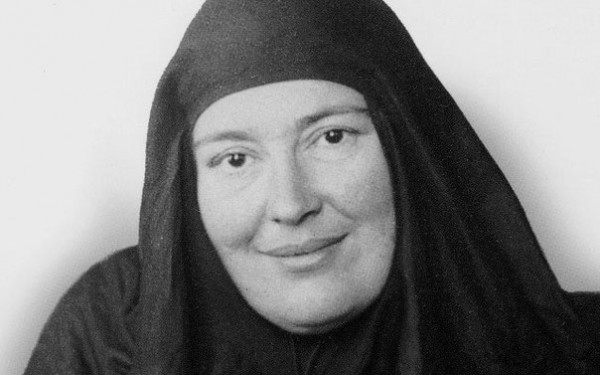
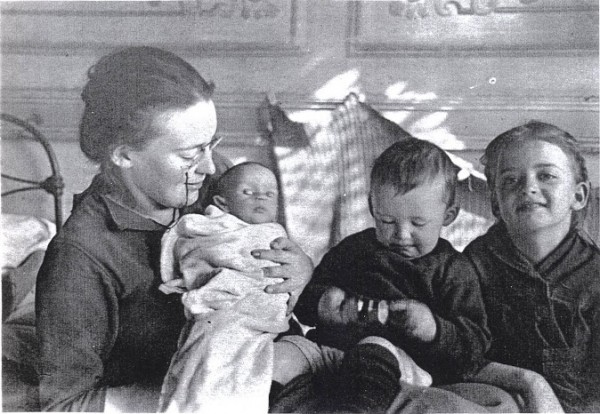
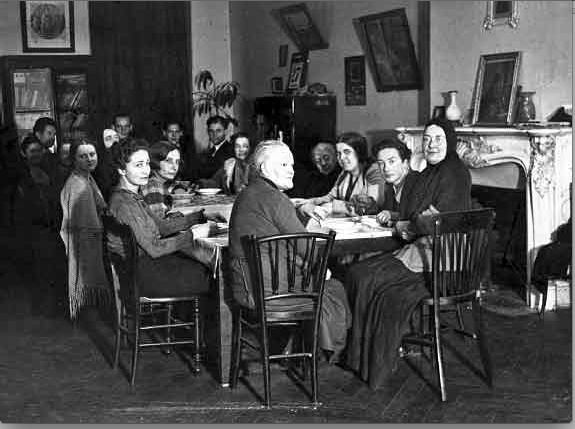
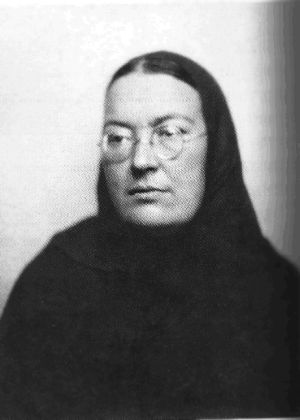
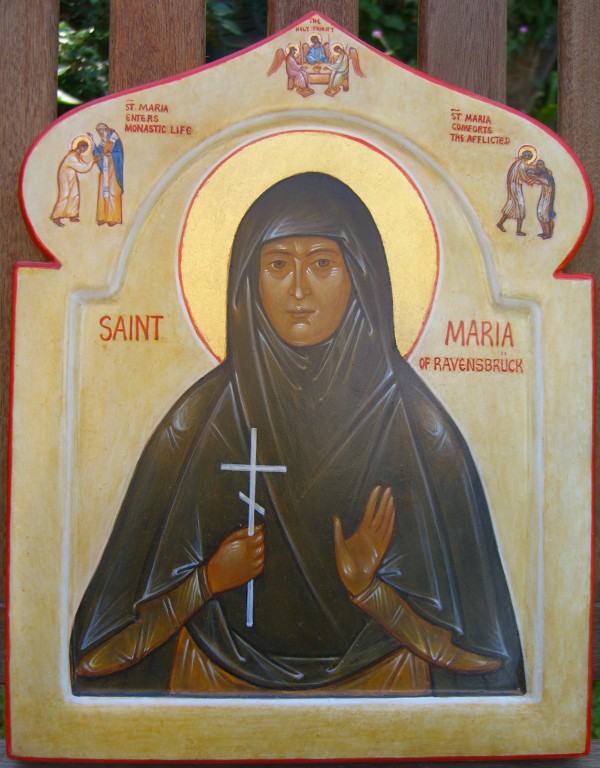
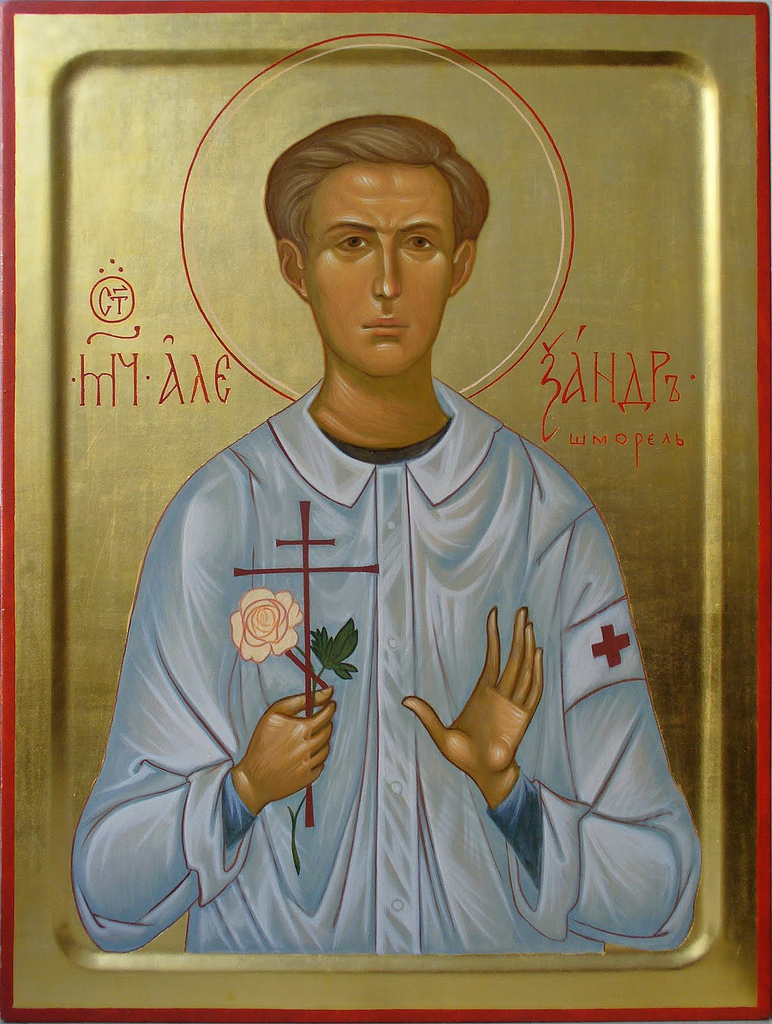
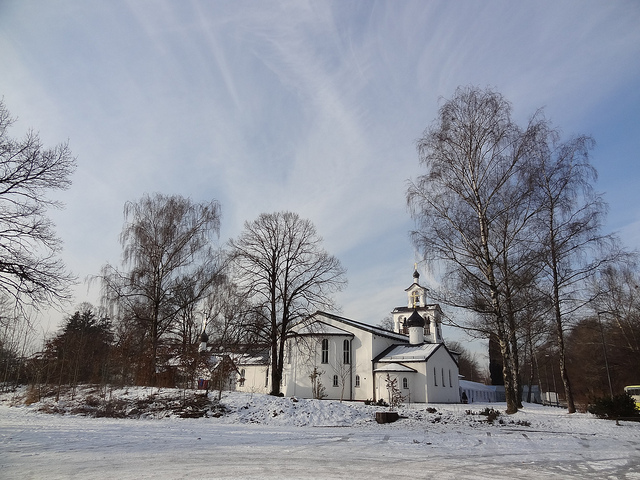

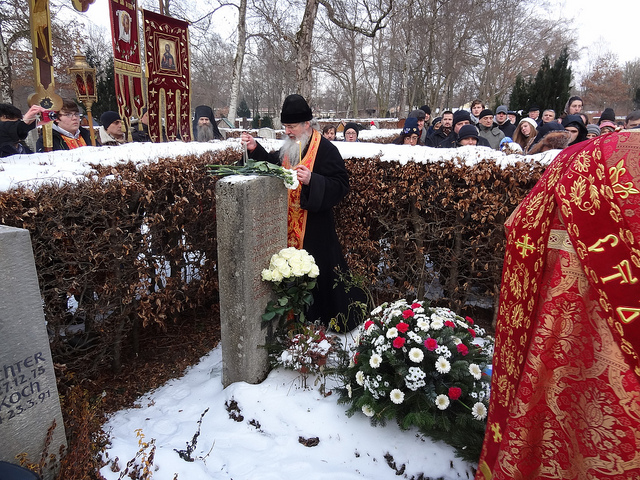
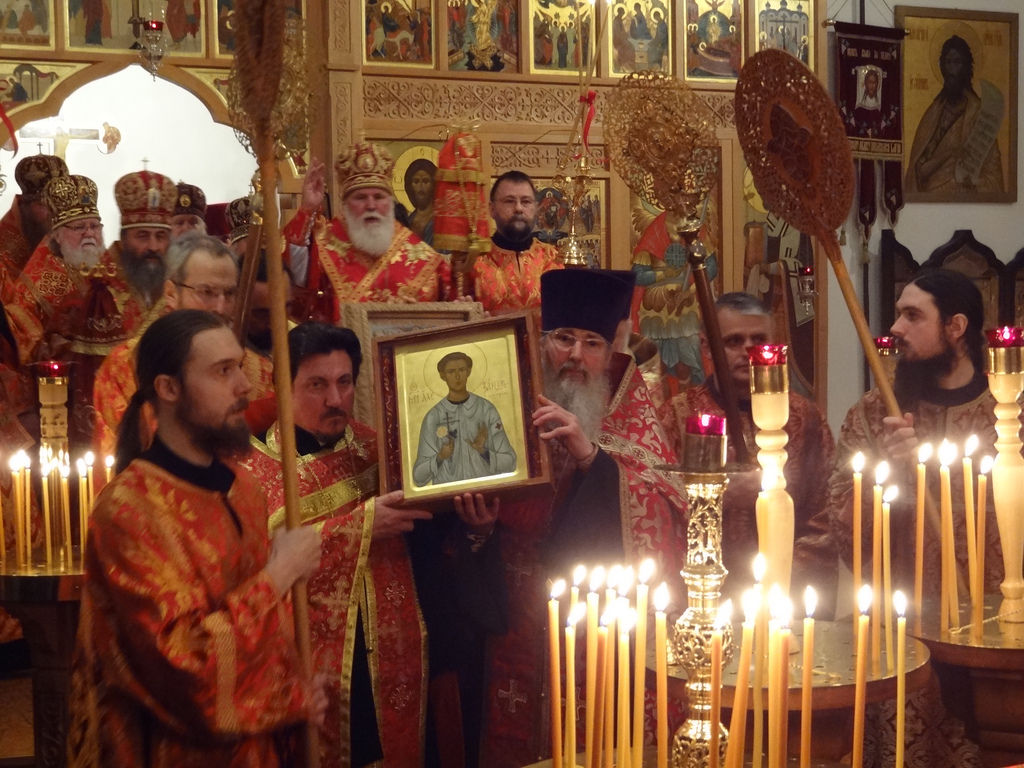
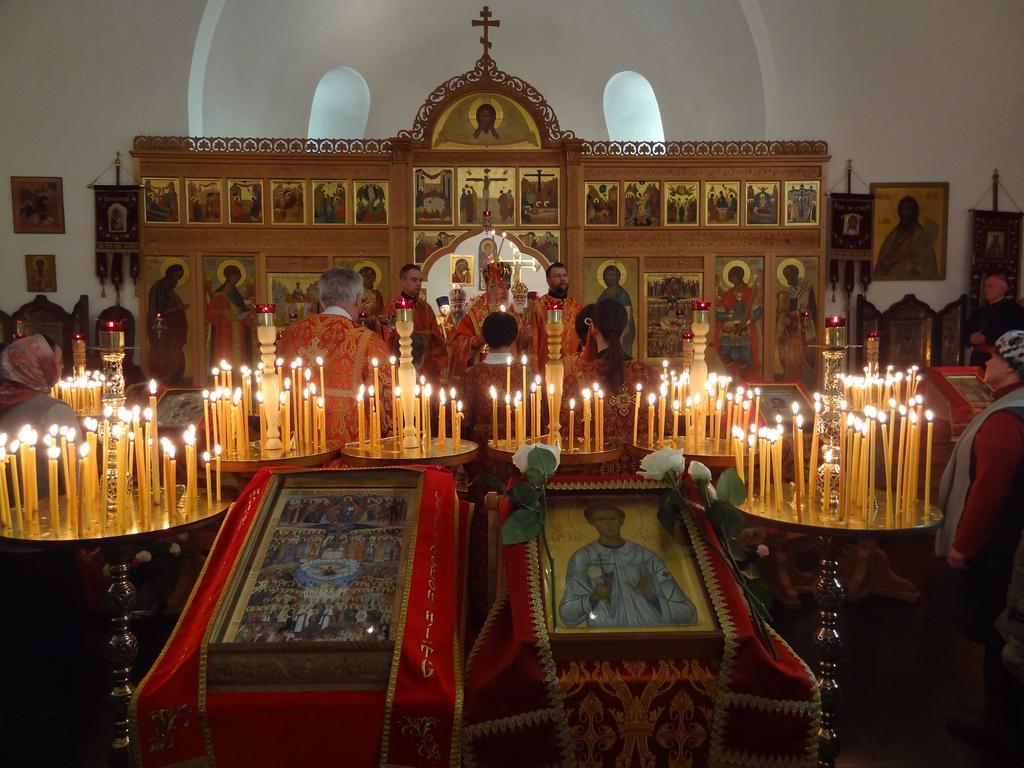
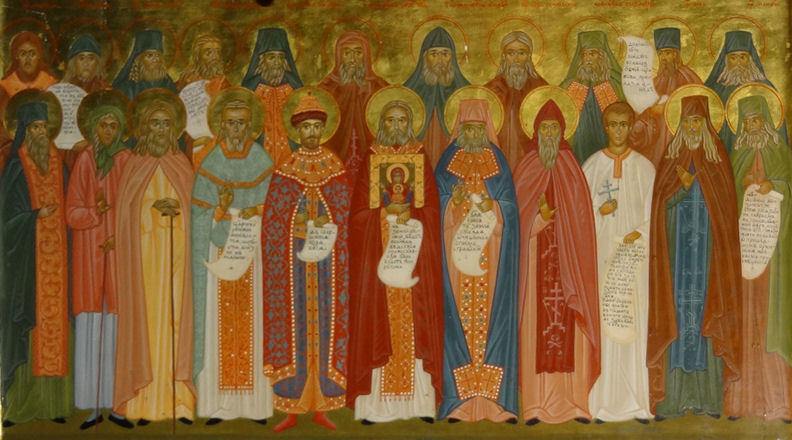







No comments:
Post a Comment